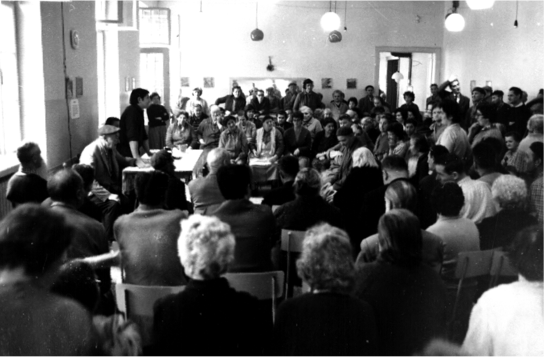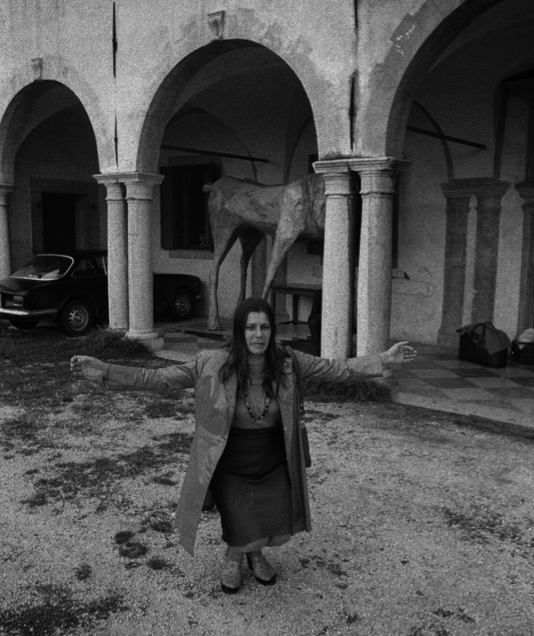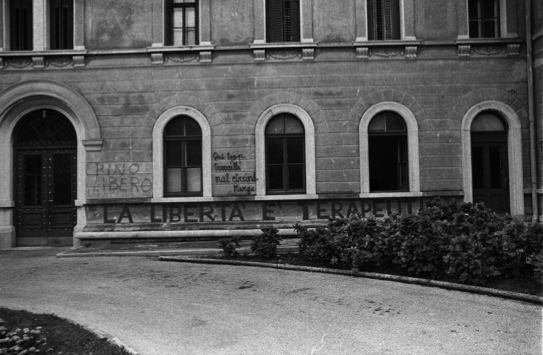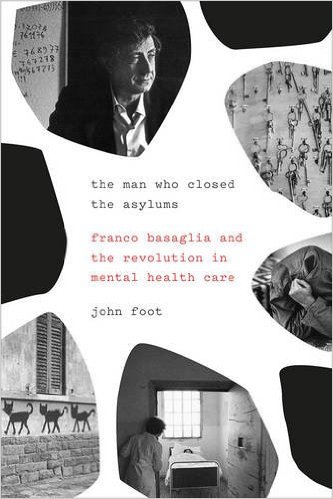Taking over the asylum: Critical psychiatry, Franco Basaglia and social struggle—By John Foot

In the lead-up to World Mental Health Day on October 10th, 2015, we look back at how the "anti-" or "radical psychiatry" of the 1960s and 1970s struggled to revolutionise the field through a critique of capitalist society in its totality. Mental illness, it was argued, was the product of a more generalised system of social and institutional oppression. This argument, as well as the centrality of the emancipation of the individual, naturally aligned the radical psychiatrists with other movements that coalesced in 1968.
We present an edited extract from The Man Who Closed the Asylums: Franco Basaglia and the Revolution in Mental Health Care, John Foot's portrait of Franco Basaglia and the critical psychiatry movement that explores how curing the 'mad' demanded a critique of the 'sane', and how revolt against the institution of the asylum pre-figured and intertwined with a rebellion against society itself. 
- General meeting, Gorizia Psychiatric Hospital, 1960s.
Anti-psychiatry is something that is difficult to capture, or study, in today’s world. At its peak, it was very much part of a mood, an eclectic movement, a Zeitgeist. It was also slippery, a slogan, a catch-all phrase, a way of pushing the envelope. It was as well, in part, an emotional reaction to a horrific system. The asylum and the way mentally ill patients were treated, and the way that sane people were often labelled as mentally ill, were clear examples for many of the most oppressive features of the capitalist system.
 - Franco Basaglia sitting among patients, Gorizia, 1960s
- Franco Basaglia sitting among patients, Gorizia, 1960s
In this regard, radical psychiatrists usually tried to understand mental illness as a social creation. What was known as mental illness, it was argued, was in some way created by social forces, inside and/or outside the family unit. This characteristic has been seen, by some writers, as the essence of anti-psychiatry. For Julian Bourg: ‘Anti-psychiatry was an international radical tendency generally inclined towards viewing madness as socially constructed. It brought the spirit of anti-authoritarian revolt to the mentally ill and their caregivers.’
Sometimes, this social analysis was extended to the whole system governing mental health care, which was placed firmly within an analysis of capitalist power structures and the ‘repression of deviance’. These strands of radical psychiatry brought together Marxism, forms of Maoism (as in the contestation of power structures, the Western translation of the Cultural Revolution) and new anti-authoritarian ideas coming out of 1968. Thus, anti-psychiatry was critical (and self-critical), social, political and cultural, all at the same time. To understand anti-psychiatry, we need to take a wide-ranging approach to the subject. As Peter Barham has argued, it was ‘far more significant within a cultural history than a distinctly psychiatric one’.
It is useful to delve a little deeper into this term or label. D. B. Double further divides up the positions taken by the various ‘leaders’ of anti- psychiatry into a number of different strands:
We can also understand anti-psychiatry by what it was against. To cite Double again: ‘The essence of anti-psychiatry derives from the sense in which psychiatry itself is regarded as part of the problem.’
Thus, in the late 1960s and early to mid 1970s, anti-psychiatry was a disparate but international political movement that aimed to reposition (in a radical way) psychiatric theory and practice. It was also a very broad church. Anti-psychiatry contained within its flexible borders a whole range of positions, which was part of its strength but also a clear weakness. Agreement was almost impossible. Sects and sectarianisms developed, as well as personal conflicts. Debates were interminable. Basaglia’s attempts to create an organization (Psichiatria Democratica) out of this mass of activists was commendable and important, but was paralysed at times by ongoing conflicts. The same was even truer of short-lived international umbrella organizations that attempted to bring together anti-psychiatrists.
Anti-psychiatry can also be understood as a more general form of methodology. There was, at the time, a general attempt to overturn, to negate what was already there, the structures of intellectual (and in this case medical) power. This ‘anti’ element was crucial to the workings of the movement. Institutional power was contested in all its forms – as encapsulated in the protagonists of this power: teachers, doctors, psychiatrists, lecturers, priests and politicians. Those with power often contested themselves, by denying their own authority, by stripping themselves of the symbols of power (white coats, for example, as a first step, but also titles), or by attempting to place themselves on the same level as those they were treating, teaching or giving sermons to.
Institutions: The Asylum and the Family

- Regina, an ex-asylum patient, Trieste, 1970s
Critical psychiatry also linked in well with a set of radical critiques of another institution which came under fire in the late 1960s across the world: the family. The family was seen by many as the place where mental illness was created, or as the only setting within which it could be explained. Laing’s research looked into the families of schizophrenics as much as it did into the schizophrenics themselves. In order to comprehend the mad, it was argued, we needed to look at the sane. By escaping from the family unit, or creating alternatives to the traditional nuclear family (through leaving home, going ‘on the road’, gay relationships and/or communes) people felt they could free themselves from the possibly toxic effects of their own families. For many young people in the 1960s and 1970s, this became a necessity. They had to get away, somehow.
Anti-psychiatry and 1968
Radical psychiatry was part of a larger movement, and to understand it we also need to look more deeply at 1968 and the 1970s. In allowing for the liberation of the self, it converged with the broader philosophy of 1968. By facing up to those described as mentally ill, people were also obliged to look into their own lives and question their own role in society. Distinctions were broken down, in every sector of society. Relationships were central to the critical psychiatry movement. These relationships changed everyone’s lives, including those of doctors, nurses and volunteers.
Critical psychiatry was never just about psychiatry. It associated mental health with society, the family, the state and its institutions, and with the psychiatric profession itself. As Basaglia made clear in L’istituzione negata, ‘Our anti-institutional and anti-psychiatric (that is, anti-specialist) struggle cannot remain within our own, specific, field of work.’ Social and political change was necessary, but required the radical psychiatrists to work with other groups.
Recognising this, Basaglia, the Gorizians and other radical psychiatrists helped to create 1968 and were very much part of the movement. They radicalized people, their writings and activity were extremely far-reaching and the movement also gave them strength and power. But they were also victims of the worst excesses of the movement: the over-powering rhetoric, a tendency towards simplification and sloganeering, the excessive verbosity.
In the 1960s and 1970s, the movement created a series of ‘working’, ‘living’ or ‘concrete’ utopias in order to experiment with alternative forms of care and spread the word about radical change. These were places where, it was argued, theory and practice would be welded together and which could inspire others. Gorizia and Kingsley Hall, in very different ways, were places that worked at a number of levels. Gorizia’s assemblies were models for the open-style meetings that would dominate 1968 – from the universities to factories to housing estates to schools. It was a simple message: everyone had a right to speak, and for as long as they liked. As Agostino Pirella later wrote: ‘For the first time, meetings and assemblies were held with all the representatives of the “institutional field” (beginning with the patients themselves) and were seen as an alternative to the madhouse and its hierarchical-repressive and “total” rules.’
These meetings were also a prototype for 1968 as spectacle, as an event which could be recounted, photographed, filmed, recorded, transcribed, studied and, eventually, also sold as a commodity. Everything was to take place in public, all would be observed. 
- ‘Freedom is Therapeutic’, painted on Ospedale Psichiatrico San Giovanni, Trieste
Gorizia was one of the stepping-stones for the long march through and at the same time against institutions, which would soon take in a whole series of other organizations, from universities and schools to the judiciary and the medical world in general. These changes tapped into themes that had emerged from a reading of the Cultural Revolution in China, with its supposed overturning of power structures and humiliation of those who held authority. Basaglian thought and practice exposed the brutal workings of the state machine, the repression of deviancy (especially the deviant poor), and extended this analysis to an entire group of institutions, beginning with psychiatric hospitals and expanding to the rest of society. It was a powerful, angry and all-encompassing world-view, and its slogans became the buzzwords for the movement. Roles were questioned, power was undermined, white coats were thrown away, symbolically and in practice. Connections were thus quickly made between 1968 and the Gorizian experiment. The two movements were a natural fit. In many ways they were one and the same.
Quite quickly and unexpectedly, asylums themselves became key sites for the organization and expression of 1968 itself. From closed and secretive areas, often on the edge of cities, many asylums opened up to the outside world, developing into places of discussion, meetings, networks of activism and cultural activity. People just turned up and took part, listened, spoke, were employed as volunteers or taken on to do jobs that they were not qualified to do. Basaglia was open to the student movement, and contact was made with student leaders from Bologna and elsewhere. As the asylums opened up towards the cities they had served, these links formed a dual purpose, breaking down stigmas towards the mentally ill and creating connections between social change, urban change and psychiatric reform.
In many ways, radical psychiatrists’ attempts to ‘negate’ their own role and undermine institutions where they exercised power approached Gramsci’s older idea of the ‘organic intellectual’. As Ortoleva wrote:
“The critical psychiatrists were perhaps the first category of intellectuals who chose to enter into dialogue with the student movement, accepting it not only as their pupil, and in some cases as an apprentice, for the transmission of their own theoretical and practical ideas and methods, but also as a motivator and interlocutor, able to give political weight to an activity which, otherwise, ran the risk of remaining isolated.”
The radical critique of total institutions, which was initiated by critical psychiatrists, struck a chord with the students who were taking on the power of the university barons. The unmasking of total institutions exposed the brutal inner workings of the capitalist system. For Ortoleva, ‘in the total institutions it was possible to read a pure, non-hypocritical, unveiled form of social “complexity”, the institutional, social and psychological ways in which authority and oppression worked’. In this situation, no compromise was possible.
The total institutions were at the same time a reality and a metaphor of the entire system: they showed the relentless contraposition between oppression and liberation . . . oppressed and oppressors, victims and butchers, they were all there [in the asylum] in their clearest expression, and it was impossible to mediate, or to avoid choosing sides.
The excluded, the deviant, the waste products of capitalism, ‘the wretched of the earth’ were to be found there, living and breathing – inside the asylums, the prisons, the orphanages. Critical psychiatrists exposed how these institutions really worked and built alliances with the students and the workers from the movement. These alliances (their form and their content) also tied in with another key slogan from the time, Rudi Dutschke’s ‘long march through the institutions’. Such was the symbiosis of theory and practice that radical psychiatrists became the ideological and, at times, political leaders of the entire movement. Radical psychiatry (at least at first) was able to combine an ethical and moral critique of capitalism and the system with a clear idea of what was to be done, and how. With time, all this would become more difficult. But in 1968, at least, the movement was pushing in the same direction. Doors were opening and barriers were broken down, both literally and metaphorically.

The Man Who Closed the Asylums by John Foot is available directly through Verso's website, with a 20% discount, free shipping and bundled ebook.
